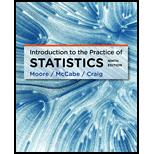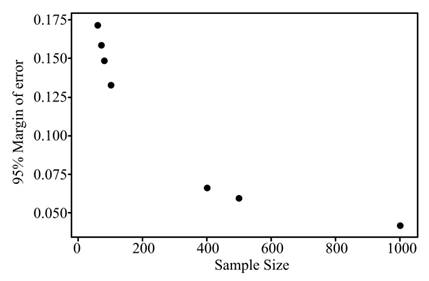
Concept explainers
To find: The 95% margin of error for the difference of two proportions for
Answer to Problem 94E
Solution: The margin of error is 0.1717.
Explanation of Solution
Calculation: The assumption made that the sample size n is the common value of
Where, z* is the critical value for the standard normal variable and
Where,
Substitute the provided values
The value of
Therefore, the margin of error is obtained as 0.1717.
To find: The 95% margin of error for the difference of two proportions for sample size
Answer to Problem 94E
Solution: The margin of error is 0.1589.
Explanation of Solution
Calculation: The assumption made that the sample size n is the common value of
Where z* is the critical value for the standard normal variable and
Where
Substitute the provided values
The value of
Therefore, the margin of error is obtained as 0.1589.
To find: The 95% margin of error for the difference of two proportions for sample size
Answer to Problem 94E
Solution: The margin of error is 0.1486.
Explanation of Solution
Calculation: The assumption made that the sample size n is the common value of
Where z* is the critical value for the standard normal variable and
Where
Substitute the provided values
The value of
Therefore, the margin of error is obtained as 0.1486.
To find: The 95% margin of error for the difference of two proportions for sample size
Answer to Problem 94E
Solution: The margin of error is 0.1329.
Explanation of Solution
Calculation: The assumption made that the sample size n is the common value of
Where z* is the value for the standard normal density curve and
Where
Substitute the provided values
The value of
Therefore, the margin of error is obtained as 0.1329.
To find: The 95% margin of error for the difference of two proportions for sample size
Answer to Problem 94E
Solution: The margin of error is 0.0665.
Explanation of Solution
Calculation: The assumption made that the sample size n is the common value of
Where z* is the critical value for the standard normal variable and
Where
Substitute the provided values
The value of
Therefore, the margin of error is obtained as 0.0665.
To find: The 95% margin of error for the difference of two proportions for sample size
Answer to Problem 94E
Solution: The margin of error is 0.0595.
Explanation of Solution
Calculation: The assumption made that the sample size n is the common value of
Where z* is the critical value for the standard normal variable and
Where
Substitute the provided values
The value of
Therefore, the margin of error is obtained as 0.0595.
To find: The 95% margin of error for the difference of two proportions for sample size
Answer to Problem 94E
Solution: The margin of error is 0.0420.
Explanation of Solution
Calculation: The assumption made that the sample size n is the common value of
Where z* is the critical value for the standard normal variable and
Where
Substitute the provided values
The value of
Therefore, the margin of error is obtained as 0.0420.
The obtained results of margin of error for different sample sizes in a table.
Answer to Problem 94E
Solution: The obtained results of 95% margins of error for different sample sizes are tabulated as:
N |
m |
60 |
0.1717 |
70 |
0.1589 |
80 |
0.1486 |
100 |
0.1329 |
400 |
0.0665 |
500 |
0.0595 |
1000 |
0.0420 |
Explanation of Solution
n |
m |
60 |
0.1717 |
70 |
0.1589 |
80 |
0.1486 |
100 |
0.1329 |
400 |
0.0665 |
500 |
0.0595 |
1000 |
0.0420 |
So, it is observed that with an increase in the sample size the margin of error reduces. Hence, a larger sample results in more accurate results.
To graph: The 95% margins of error obtained for different sample sizes.
Explanation of Solution
Graph: To obtain the graph of 95% margins of error for different sample sizes, Minitab is used. The steps followed to construct the graph are:
Step 1: Enter the data of the sample sizes and the associated margins of error values in the worksheet.
Step 2: Select Graph-->
Step 3: Select Simple from the opened dialog and click on OK.
Step 4: Select the Y variables as margin of error column and X variable as sample size column and click on OK.
The graph is obtained as:

To explain: A short summary of the obtained results.
Answer to Problem 94E
Solution: The obtained results of margins of error and the graph shows that the margin of error decreases as the sample size increases. But the rate of decrease of margin of error is very less for large n.
Explanation of Solution
Hence, a larger sample is desirable for a lower error.
Want to see more full solutions like this?
Chapter 8 Solutions
Introduction to the Practice of Statistics
 MATLAB: An Introduction with ApplicationsStatisticsISBN:9781119256830Author:Amos GilatPublisher:John Wiley & Sons Inc
MATLAB: An Introduction with ApplicationsStatisticsISBN:9781119256830Author:Amos GilatPublisher:John Wiley & Sons Inc Probability and Statistics for Engineering and th...StatisticsISBN:9781305251809Author:Jay L. DevorePublisher:Cengage Learning
Probability and Statistics for Engineering and th...StatisticsISBN:9781305251809Author:Jay L. DevorePublisher:Cengage Learning Statistics for The Behavioral Sciences (MindTap C...StatisticsISBN:9781305504912Author:Frederick J Gravetter, Larry B. WallnauPublisher:Cengage Learning
Statistics for The Behavioral Sciences (MindTap C...StatisticsISBN:9781305504912Author:Frederick J Gravetter, Larry B. WallnauPublisher:Cengage Learning Elementary Statistics: Picturing the World (7th E...StatisticsISBN:9780134683416Author:Ron Larson, Betsy FarberPublisher:PEARSON
Elementary Statistics: Picturing the World (7th E...StatisticsISBN:9780134683416Author:Ron Larson, Betsy FarberPublisher:PEARSON The Basic Practice of StatisticsStatisticsISBN:9781319042578Author:David S. Moore, William I. Notz, Michael A. FlignerPublisher:W. H. Freeman
The Basic Practice of StatisticsStatisticsISBN:9781319042578Author:David S. Moore, William I. Notz, Michael A. FlignerPublisher:W. H. Freeman Introduction to the Practice of StatisticsStatisticsISBN:9781319013387Author:David S. Moore, George P. McCabe, Bruce A. CraigPublisher:W. H. Freeman
Introduction to the Practice of StatisticsStatisticsISBN:9781319013387Author:David S. Moore, George P. McCabe, Bruce A. CraigPublisher:W. H. Freeman





